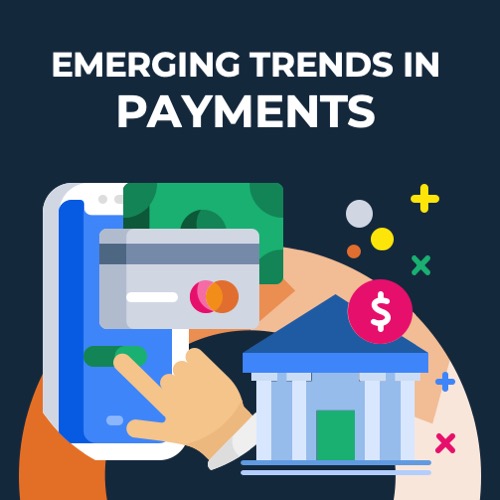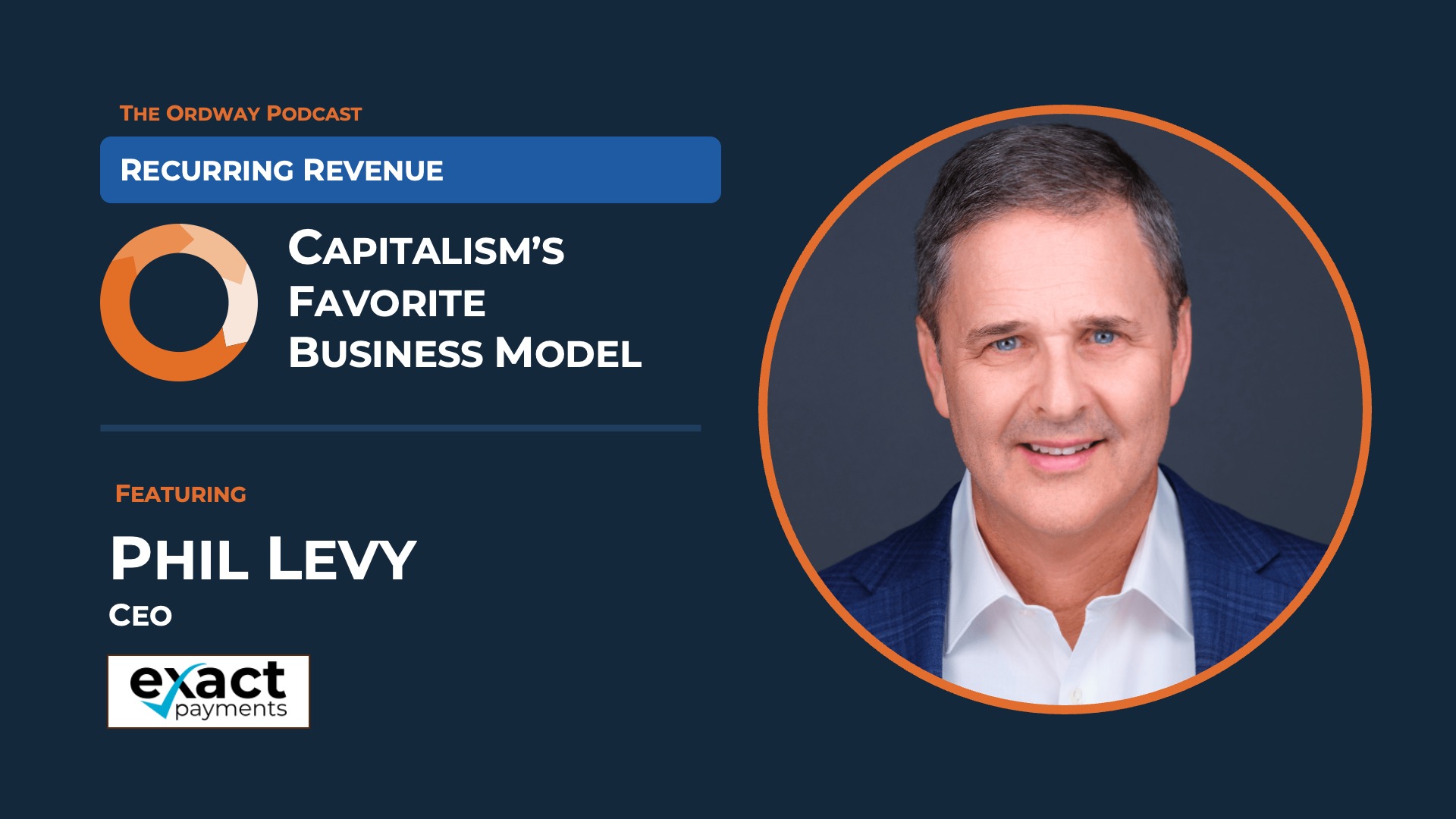
The Ordway Podcast: Capitalism’s Favorite Business Model
Emerging Payments Technologies
Phil Levy, CEO of Exact Payments, discusses three emerging payment technologies that B2B SaaS companies should be aware of – 1) digital wallets growing adoption across channels, 2) network tokenization models to reduce fraud, and 3) real-time payments for automated clearinghouse transactions.
Episode Summary
One of the most important components of the recurring revenue business model is collecting payments from customers. While the process almost appears effortless for customers, there is a lot of complexity behind the scenes to make enrollment in recurring billing convenient, to minimize the risk of fraud, and to offer a flexible list of payment options for customers to transfer funds. There is another wave of emerging payment technologies on the horizon that promises to bring even greater convenience, security, and flexibility to SaaS companies. In this episode of the Ordway podcast, we explore digital wallets, network tokenization, and real-time payments.
Introduction to Exact Payments
Steve Keifer:
So glad you could spend a few minutes here with us. I really want to dig into some of the really interesting emerging payment technologies that are on the horizon. But before we get into that, maybe we could offer the audience just a little bit of context about yourself and the company, Exact Payments. Maybe start with the Exact Payments side. Tell us a little bit about who you guys are, and the value prop, and what you do, where you fit in the payments ecosystem.
Phil Levy:
Absolutely, Steve. Thank you. Yeah, Exact Payments is a three-year-old company. We got launched in November of 2020, just when COVID was making it fun to start and launch a business. And we are a group of longtime payment experts, built systems for a variety of different companies in the payment space over the years. And we came together against a mission to build a suite of modern technology that is the easiest to integrate, most scalable and most comprehensive suite of payment services. And we’re building this technology for software platforms. You may recall that as a marketer, the marketing tagline that Intel used for many, many years was Intel Inside. The idea was, hey, the power, the brains of your Dell computer or your Apple computer or your IBM computer was actually that Intel chip. And I kind of like that for us. We are the embedded payments engine, the payments brain inside lots of different vertical software solutions.
Background – Phil Levy CEO of Exact Payments
Steve Keifer:
I know this is not the first time that you’ve been at a payments company. Over the past couple decades, you’ve been at a lot of banks and financial tech companies. Maybe tell us a little more about that before we discuss payments further.
Phil Levy:
I’ve been in technology my entire career, but since 2001, I’ve been in financial services related technologies. The term we use for it now obviously is FinTech with companies like a mid cap company called eFunds that was also a financial services company. I’ve done some startups in the space earlier on, all across the spectrum from B2B services to B2C services, e-commerce, retail, in-store technology. And throughout it, I’ve really seen both well done solutions and less well done solutions and came to have an appreciation of what it takes to build really great technology that’s easy for your customers to use. And that’s one of the principles that we’re really driving across our team here is if the technology is difficult to understand, if it’s difficult to integrate with, if it’s difficult to build new services with then it’s of limited value to your customers. So trying to take a lot of the best lessons I’ve learned and bring them to the team we’re building here.
What is a Payfac (payment facilitator) and how does it interact with the card networks, merchants, and financial institutions?
Steve Keifer:
I keep hearing about payment facilitators and pay facs. Maybe you could start by just giving us some perspective. What is a payfac? And how does that kind of fit into this ecosystem? You’ve got the acquiring bank, the issuing bank and the card networks and the merchant and the customer like where’s the payback fit? What is the role that in the ecosystem?
Phil Levy:
Great question. And one that’s really misunderstood, even within our industry. So like a lot of things in the payments space, around 2010, Visa MasterCard primarily were thinking, geez, you know, we see the shift towards digital, we see the pie growing in terms of electronic payments. But there’s one segment that’s extremely problematic, and that is the small, sometimes known as micro merchant or micro seller market, which even back, I think you’ll remember 2010, in that space, it was still a lot of cash. And so you could imagine from the economists at Visa MasterCard to the guys setting the strategy there, the team setting the strategy there. They were very anxious to figure out how to go down market and turn that to electronic payments. The issue is that payments were always done through having to go to your bank, which nobody really likes to do. It’s full of friction. And from a bank’s perspective, it’s too costly to open an account for a micro merchant. Someone’s going to have a balance of $300 in their account. Maybe have a big month where they sell a couple of thousand dollars. It’s not a profitable account to have at a commercial bank. And so there wasn’t much interest to go and take on the upfront cost of onboarding and underwriting that account.
Yet you had this proliferation of technology providers, companies like ours, who had digital ways of acquiring those customers, online mechanisms, and then they, a spate of risk services that we could connect to, to do identity verification, to do anti-money laundering research, all sorts of things that are known as KYC and KYB, know your customer, know your business. So once you start pulling that all together, now your custom customer acquisition for a small business or a micro merchant makes it profitable.
And so what Visa MasterCard had to do, and they don’t get to call the shots unilaterally, they have to go to their member banks, the issuing banks and the acquiring banks, as you pointed out, and they have to get them to accept a rules change, which allows a company like ours to make the underwriting decision. Prior to the payment facilitation model, the only one that could be trusted to do that would be a bank. And so that democratizes the whole economy. And so it’s a very high bar for a company like ours to go through a review from a bank and be approved to operate in this model. But once approved, we get to make all of those decisions. There’s certain compliance responsibilities we take on, certain risk management responsibilities we take on. But there’s a whole army of companies out there now that can get to pockets in the economy and convert cash transactions to digital electronic transactions. And that’s driven tremendous growth over the last 10 years for issuing banks, acquiring banks, Visa MasterCard, and everybody in between.
How does a Payfac make it simpler for startups, SaaS, and cloud companies to accept card payments from customers?
Steve Keifer:
So they’ve effectively kind of expanded the addressable market for cards by lowering the customer acquisition costs through companies like yours that do all the underwriting, KYB, KYC, AML, all that fascinating stuff. Yeah, that is game-changing. So a lot of the companies that a lot of the audience that follows the podcast and a lot of the companies that we sell to at Ordway are SaaS and cloud companies, by marketplaces. And some of them are 100 million on their way to a billion dollars in revenue. But we also have a lot that are very early stage, maybe in stealth mode, just raising their seed round now, really haven’t launched officially. And one of the most common questions we get asked is, how do we get our customers on autopay? How do we get this whole recurring billing thing going? So maybe asking you the same question about the payback, but from a different perspective.
How does the payfac model make it easier for these smaller tech companies and SaaS companies to get up and running?
Phil Levy:
Let’s look at the two primary options that one of your customers still has today. The first option, the old model, would be for them to put together their own payment solution. That will include starting with a typically a bank and you can there are other resellers of merchant accounts that for banks that agents and ISOs people who are in the streets every day selling new payment terminals to the local deli and the local dry cleaner. That’s been going on for 30 years. But ultimately it’s a bank that is giving you an account where they’ll process your payments and they’ll fund your payments. They’ll provide support. So that’s the first component. Then the second component is great, I have a bank. The bank will probably recommend a payment solution. Sometimes it’s called a payment gateway.
And I’ve got to figure out how to connect to that. That could be as simple as they give me a payment terminal for my store and that’s how I transact. Or it could be if I have an e-commerce channel, a mobile app, it takes more integration to one of their interfaces, their APIs. So that’s a bit of a project. Then I might ask myself, well, geez, if I’m transacting, I need to consider risk management and fraud, so I might need a vendor for that. So it becomes a project. And contrast that, Steve, to software companies like Ordway, who’ve seen this coming for a number of years and said, hey, we’ll take care of all of that and we’ll build all the payment functionality using technology, not, I don’t think building it all yourself, using a partner.
So it’s all integrated because Ordway is a billing platform. So the natural final step in that order to cash cycle is, I have my invoice, my invoice is correct, I’m ready to pay, I wanna pay through a variety of different choices you give me, I’ve initiated that payment, and a day or two later, the money is in the seller’s bank account. That’s the happy past story that you guys facilitate at Ordway because you have the foresight to build this technology right in. Now it’s a one-vendor, one platform solution for the entire order to cash cycle versus having to put it together like a Lego building project.
Steve Keifer:
Who wants to waste time and capital on going out and building your own payment infrastructure with an ISO or one of these kind of legacy types of models? That doesn’t make any sense. It certainly didn’t make any sense for us. We were able to quickly accelerate time to market and definitely lower the friction and improve the customer experience by just using a turnkey payback as a service. So it makes a lot of sense. And it’s also interesting to just kind of ponder the opportunities that this opens up because I was talking to someone the other day and they were asking me about Ordway and who we sell into and I said, well, we sell into technology companies and they said, well, what does that mean? I said, you know, software companies, cloud companies, well, isn’t every company a technology company these days? Which is a good point. You start to wonder like companies like yourselves that are making this so easy, do we get to a point where every company is a financial services company 10 years from now because everyone has been able to monetize payments or do these kinds of things because the friction and the effort has been lowered so much. So, anyway,
How do you see the adoption of digital wallets growing in the coming years?
Steve Keifer:
Let’s go back to the original topic of the interview, which is emerging payment technologies. I know one aspiration that you know, every bank and certainly the card networks always have is, how do we just make it even easier for people to make payments, whether it’s in person or online and, the growth of digital wallets and click to pay and stuff like that, certainly seen it evolve to become mainstream over the past few years in the consumer space. I know you guys have launched some initiatives around that recently, but just wanted to get your perspective on the adoption of these lower friction digital wallet types of transactions and where you see the market going there.
Phil Levy:
Excellent topic in my space. It’s definitely the case that over the last several years, the pace of adoption for various wallet solutions, the best known of course being Apple Pay and Google Pay, since everybody in the US has either an iPhone or some kind of Android phone. Those wallets are the best known and they’re growing very rapidly. But of course, there are a whole range of other wallet options. Some are well known and some are just emerging. PayPal, is obviously very well known. Now you see extensions with PayPal where you can get Venmo payments. And these things are very aligned with demographics. So for instance, I don’t have a Venmo account. I’m unlikely to open a Venmo account, but I’m not their target demographic. My 24-year-old son is their target demographic.
Who will be the market leader in digital wallets? Will it be Apple and Google? Or a traditional payments company?
Phil Levy:
Now, in addition to PayPal, Venmo, and Visa MasterCard here again, are an interesting case study in that they’ve had, depending on how you count it, two or three passes in the market to create their own digital wallet offerings.
And I don’t get to sit in those conversations, but I would imagine in their executive meetings, they’re none too happy that Apple and Google are dominating them in the wallet share. And so their latest initiative is something of a standard. And since all the issuing credit card issuing banks are members of either Visa or MasterCard for the most part, they’re sitting in a wonderful position to get penetration in all of those issuing banks’ portfolios, cardholders like you and me. And that initiative is called Click to Pay. It is just emerging. We are just releasing it in a beta fashion this quarter and a general release after the first of the year. We’re doing it in partnership with MasterCard, but the wallet will allow you to put any of your preferred cards in there. A Visa card, a MasterCard, an Amex, a Discover. Choose which is the primary card, which is a backup card, just like you would in a leather wallet you might have in your pocket. It’s gonna be very secure. It’s gonna be very one-click. It’s gonna recognize you. It’s gonna shoot a one-time password to your phone a six-digit code, you enter that and your payment’s done. So very excited to see how that performs in the market. These things tend to take time to get adoption because right now if you were to ask someone on the street, have you heard of Apple Pay or Google Pay? Probably 80% would say yes. If you ask them, have you heard of Visa and MasterCards? Click to pay. They haven’t done any. But imagine after the Super Bowl, they run a Super Bowl ad. Now people will say they had a great commercial on the Super Bowl. So they have that kind of market power when they get behind something. Boy, there’s a whole bunch of other wallets that are coming as well. Some people are familiar with Zelle. Zelle has a wallet offering that they’re out trying to push. So we’re, we fall very closely and we work with these companies. We give them access to some of our clients for beta testing and so forth.
Digital wallets – Past, present, and future
Phil Levy:
But I think what you’re going to see, Steve, is over time, 10 plus years, how you and I, and I know I still do this, certainly in the last week I’ve done it more than a few times. Why are we going through this process of entering our bill to information, entering our ship to information? The same on 90% of the transactions unless you’re sending someone a gift. So making that a one-click experience is a no-brainer. I think five, 10 years from now, nobody will have a plastic card they have to worry about. It will be your digital wallet is the way you pay.
Steve Keifer:
Yeah, it’s fascinating because I remember, even back in the dot-com era, people talking about these digital wallets. It’s just that nobody’s really been able to crack the code on it, but you’re right. It’s it’s amazing that you know what going through the holiday season just taking out my card and typing in those numbers and The CVV and the expiration date and all that stuff. It’s the moment of truth for the consumer at the checkout, right? You know the fact that you’re having to go look hunt for your card physical card and get that stuff, I imagine the card abandonment rate is driven somewhat by that.
Phil Levy:
Well, just to go back in time, like when you were talking about the dot com days, and it shows what a payment geek I am. At that time, you may remember there were some initiatives around biometric payments, paying with your index finger. And I was so excited about that at the time because it seemed to me that something I always had with me was my right and left index finger. And at that time, if I’m sure I had a phone, but I didn’t, it wasn’t with me within arm’s reach at all times like it is today. And I was just in the airport last night and I always chuckle when I look around, there’s not a single person that’s not on their phone at all times when you’re sitting waiting to board your flight. So that’s just how ubiquitous these things have become. And so I think the confluence of that just means that wallets are absolutely the future.
Steve Keifer:
Yeah, it’s hard to imagine what we used to do when we didn’t have a phone and we were waiting in line for something mess when I don’t have it. But yeah, actually the Whole Foods near me has that pay-with-your-palm thing that Amazon’s got. I haven’t had time to enroll in it yet because I’m always in such a hurry when I’m going in and out of there, but I have to try that.
What is tokenization of credit card data?
Steve Keifer:
Some of the most coveted information on the internet is, of course credit card numbers and the industry I think has done an amazing job with PCI and chips placing magnetic stripes and all the interesting things we’ve done in the past 10 or 15 years to cut down on that, but it’s still a big problem. One of the things I wanted to ask you about was tokenization, and specifically, I heard you mention a few times this concept of network tokenization. So maybe you could talk a little bit about what tokenization is and then why this emerging payment technology is such a game changer.
Phil Levy:
Another great topic. Tokenization is a concept at its highest level where you take a piece of information, and you replace it with some algorithmically derived value. Of course, everybody recognizes that a credit card number is a very valuable piece of information and has probably seen presentations where someone who’s out to commit fraud; if they know what they’re doing, they can find repositories of credit card, stolen credit card data for sale online in the internet. And if, and there’s a price list for these criminals, if you just get the card number, that’s cheap, if you get the card number with the three-digit code, that’s a little more expensive. If you get the card number with the three-digit code and the billing zip code, that’s the most expensive purchase. So this goes on every day, and it’s been a real sticking point for those of us who operate in the payments industry. So now you think about tokenization, you say, how do I beat these guys? I get rid of all the credit card numbers, and I replace them with algorithmically derived values that cannot be used to transact. Okay. And I think we’re doing a little bit of jumping back 10 years and 15 years. But you’ll remember not so many years ago, we used to read about breaches all the time. I bet you can name the target breach the Home Depot breach. Why do you think we don’t hear about that? And they still happen, don’t get me wrong. But why don’t we hear about those near as much as we used to? Because everybody is replacing stored card data with tokens.
What are the benefits of the new network tokenization being introduced by the card networks?
Phil Levy:
When tokenization first came out, companies like ours created their own algorithms. And we would convert credit cards to these tokens. You’d pay with a token. We knew the association between the token and the actual credit card number. We would pass that in, and it would process just fine. Those are called they have various names – gateway tokens and processor tokens, but they’re proprietary. So my tokenization standard is not the same as Stripes, it’s not the same as WorldPay, it’s not the same as any player out there; it’s proprietary to me. And so network tokenization is the four card networks, Visa, MasterCard, American Express, and Discover, getting together and saying, let’s create a standard.
And because the issuing banks that issue credit cards are part of their network, they accept the standard. And now they’re creating and managing these tokens, which drives a lot of advantages over even my proprietary tokens. Okay, and we love our proprietary tokens. They’ve secured our environment for years, but we’re out now advocating for a shift from our tokens to network tokens, and there’s a ton of value.
First of all, Visa is publishing case studies that because of the way network tokens get issued and the amount of data the issuer has associated with it, the authorization approval rate is going up by 4% to 5%. So that would be like you going to your customer, Steve, and saying, through you doing nothing other than switching to network tokens, you can increase sales by 5%. Most of your customers would sign up for that in a heartbeat.
There are many other advantages, big 26% reduction in fraud. Visa is reporting, that everybody wins that 26% reduction.
And then lastly, it’s this concept of portability. So one thing that’s happened in our business is when you integrate with someone like us or any of my competitors, it’s not always easy to say, you know, I want to move my business, or I want to move part of my business and tokenization, proprietary tokenization made it even more difficult and still persist today because somebody wants to move. They have 10,000, a hundred thousand records. They’re in my proprietary format. They cannot move those to someone else. Network tokens are universal and can be used by anybody.
The portability aspect is another big win for the industry. And we’ve always been a believer here, Steve, that if you do what’s right for the customer in the end, the merchant, the seller, ultimately, your business will prosper, too. If you try to lock people in with the pace of change in any industry and the pace of change in technology, It’s never a winning strategy, that’s our view. So we’re big proponents of network tokenization. We’ll be making some announcements right after the first of the year with Visa on some case studies in our portfolio. And you’ll hear more and more about it going forward.
Steve Keifer:
Yeah, and just listening to you explain that, if I’m connecting the dots right, that’s gonna help us as a billing provider, I think. One of the big challenges that we always face when we’re implementing new billing systems, the customer comes to us and says, we’re on Stripe, but it’s expensive, and there’s not really much customer service. I’d love to move to the Ordway, Exact Payments powered solution, but there’s always that, yeah, but I’ve gotta get the card numbers moved over and go through all, jump through all these hoops and do gymnastics to get them moved over. So if they’re on the network, that becomes almost effortless, hopefully.
Phil Levy:
That’s right. It’s a universal standard, so fully portable.
What are real-time payments? How is it different than traditional ways of transferring funds between accounts?
Steve Keifer:
We talked a little bit about how emerging payment technologies are making things more convenient and reducing fraud. But the third was around the speed at which the money moves and maybe switching gears from the cards world to the bank transfer and automated clearinghouse world. I know that.
The Fed and the other ACH provider, The Clearinghouse in the US, are introducing this concept of real-time payments. Again, I kind of pinch myself and go, is it really almost 2025 and we still can’t do real-time payments in the US? We have to wait three days for money to move. So I’m personally happy about it. But I just want to get your perspective on how quickly you see the adoption there. Are there any challenges? What do you think the impact is to the market of this real-time payments initiative?
Phil Levy:
Yeah, yeah. Well, I think it’s right to pinch yourself because we’re always for as advanced an economy as we are, we’re always on the payment side. US is last many times we were last to convert to EMV chip cards. Europe had them 10 years before we did. And Europe’s had most EU countries have had real time payments for it’s pretty de facto for three or four or five years. So obviously the pervasive account to account payment type has been the ACH network, automated clearinghouse, it’s been up and running for decades. And we’re all used to paying, making a bank payment, whether it’s for a mortgage or on auto pay or any other debit out of your account. Just to put a point on that, not all ACH is necessarily that three to four day. So within the ACH network, you can also have next day settlement. And there is a same day settlement option as well. Obviously, each of those services is a little more per transaction than your standard ACH, which two to three, sometimes four day settlement, depending on which bank. Now, as you referenced, there is a new company that’s been out in the market for several years. It’s called The Clearing House. I think they’re out of Charlotte, North Carolina. And they’ve built a network, a bank account to account payment network that they call RTP real-time payments. And that truly is move money at any time a day 24 hours by seven. The ACH network, even when they say same day ACH, it has cutoff times, two o’clock in the afternoon and so forth. This is 24 hours a day. You wake up at two in the morning and say, geez, today’s the day I need to make my payment on my mortgage. The money moves instantaneously. And you’re starting to see adoption of that. We offered in limited cases. And the reason I say limited cases is you need to be a little careful. The rules and the ability to get recourse are well established in the ACH network. In the RTP network, not to say there aren’t rules, but because it’s new, your recourse on a transaction is much more limited. So it’s the certainty that you need to have in advance of moving $100, let alone, let’s say $100,000 commercial payment. There’s a different standard there. So we spend significant time with folks establishing, let’s get very clear on the use case, let’s do some limited testing with some customers before you make it a general availability. But I don’t think there’s much doubt that there’s a huge demand for faster money movement account to account. The fees on account to account payments are lower than credit and debit card. Well, certainly than credit card. And so that’s attractive, especially for in a B2B context. And then lastly, some of your listeners may be aware of the Federal Reserve now getting in with a network called FedNow.
That’s been announced. It’s technically online. A lot of the same principles here of instantaneous payments. Some caution around the certainty of money movement. And as I understand it, we’re not participating in that yet. There’s about 25 or 30 of the largest banks, a couple of the bigger service providers that are in some kind of beta phase. It’s a little hard to say exactly what they’re doing. And there’s not a whole lot of actual transaction activity, but that bears watching as well. So I think we’re going to have gotten from, Hey, there’s only one flavor of account to account payment, bank to bank payment, to multiple options in the US market. And of course that’s a good thing.
Steve Keifer:
Excellent. No, thank you for talking through that. I knew enough to be dangerous about that, but I haven’t heard anyone as clearly explain all those different models there. So that was very helpful for me and, hopefully, for our audience. Yeah, in the B2B space, it’ll be interesting. Hopefully, we see the quick adoption of that. I know there’s still a lot of paper checks floating around out there because CFOs like to take advantage of the float. So hopefully, they move to these faster payment models and don’t drag their feet and stay with the two to three-day stuff. But I guess time will tell.
What are some of the other emerging payment technologies that SaaS companies should be aware of?
Steve Keifer:
Are there any other emerging payment technologies you wanted to mention or anything else about Exact Payments you wanted to share before we close out?
Phil Levy:
Well, no, I think you’ve covered some of the really important things. Obviously, the nature of embedded payments, the concepts of security at some point in the future, maybe we could visit on that topic. It’s a little mundane, but it’s critically important to understand how throughout the value chain from the billing platform through an embedded payments infrastructure all the way through settlement and funding, how the ecosystem is secured. And really, those are heavy considerations for any customer of yours, any customer of mine. So that’d be a topic that would deserve, probably a session of its own. But you’ve hit on some of the things that we talk to folks about every day. So that’s been great.
Steve Keifer:
Well, I’ll definitely take you up on having you back at a later date, and we can dig into some of that security stuff. For those in the audience that want to learn more about Exact Payments, you can check them out. They’re exactpay.com. I can tell you, we use them at Ordway. And often when you think about payments, you just kind of focus on the per unit transaction cost. But there really is a big difference just in the customer experience, the easy use of the platform, that we have certainly benefited from working with Exact Pay. So I appreciate everything that you guys do and thanks so much again, Phil, for taking some time to spend with us. I know I learned a lot, and hopefully the audience did, and we’d love to have you back on a future edition.
Phil Levy:
Yeah, thanks. I want to make sure that everyone knows that we at Exact Payments, we have a very sophisticated usage-based billing model as a SaaS provider, and we do our billing through Wardway. So your software has helped us enormously, saved us a ton of hours every month. And so thanks for having me. It’s been fun.
Steve Keifer:
Always good to hear. Thanks everyone for joining, and we look forward to seeing you again on a future edition of the Award-Away podcast where we talk about recurring revenue, Capitalism’s favorite business model.
Frequently Asked Questions
What are the most important emerging payment technologies for SaaS companies?
The top three are digital wallets, network tokenization to prevent fraud, and real-time payments for instant fund transfers.
How do digital wallets improve the payment experience for B2B SaaS customers?
Digital wallets enable one-click payments, reduce friction during checkout, and increase convenience for recurring and online transactions.
What is network tokenization, and why is it safer than proprietary credit card tokens?
Network tokenization replaces real card details with secure, portable tokens managed by card networks, reducing fraud by up to 26% and boosting payment authorization rates.
How do real-time payments differ from traditional ACH bank transfers?
Real-time payments move funds instantly any time of day, compared to several days for ACH, making them ideal for fast B2B transactions and improving cash flow.
What are the benefits of using a payment facilitator (Payfac) model for SaaS platforms?
Payfacs allow SaaS businesses to embed payment processing, automate onboarding, minimize risk, and scale payment capabilities quickly without legacy banking hassles.
Recent Blog Posts







